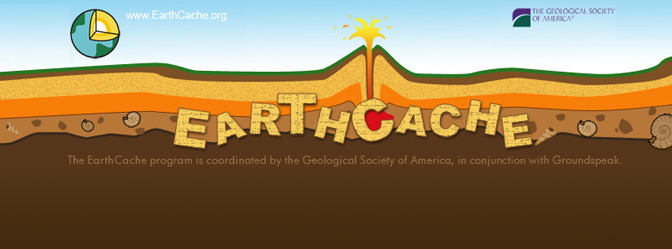
Vítám Vás na mé další Earthcache, která se nachází poblíž zámku v Českém Krumlově.

Geologie
Region Českého Krumlova geologicky spadá do předplatformního podkladu Českého masívu, konkrétně do moldanubické oblasti. Moldanubikum je termín používaný pro oblast, která je tvořena převážně intenzivně metamorfovanými horninami s granitoidními masívy stáří variského orogénu. Tato oblast je jednou z nejstarších geologických jednotek v České republice.
Konkrétně v oblasti Českého Krumlova, která je součástí šumavského moldanubika, se nachází různé horninové komplexy, které prošly katazonální metamorfózou. V moldanubiku je běžný výskyt vysoce metamorfovaných hornin, jako jsou granulity, eklogity a další druhy hornin. Zde se také vyskytuje intenzivní migmatitizace a intruze granitických hornin.
V moldanubiku lze identifikovat dvě různé série hornin s odlišným horninovým obsahem. Jednotvárná série je charakterizována různými typy pararul (biotitické, silimanitické, muskovitické), které byly migmatitizovány. Pocházejí pravděpodobně z původních pelitických a psamitických sedimentů hlubokého moře. Pestrou sérii tvoří také pararuly, ale kromě nich se vyskytují také kvarcity, kvarcitické ruly, erlány, grafitické horniny, mramory, amfibolity, amfibolické ruly, granulity, eklogity a ortoruly.
Pestrá série tvoří několik pruhů v moldanubiku, a jeden z nich prochází středem Českého Krumlova. Stratigraficky je považována pestrá série za mladší. Její stáří je stále předmětem diskusí, ačkoli radiometrické datování naznačuje stáří alespoň středně proterozoické, což by bylo staré přibližně 523 milionů let. Horniny této oblasti prošly minimálně dvěma deformacemi a případně i metamorfózou, které se označují jako deformační fáze "moldanubická," "kadomská" a částečně také "hercinská."
Tyto horniny se označují jako metamorfované a patří mezi ně i pararula, která se nachází na úvodních souřadnicích.
Pararula
Pararuly jsou vysoce variabilní horniny, zejména co se týče jejich vzhledu. Vznikají z původních sedimentů s různou zrnitostí, jako jsou pelitické, alueuritické nebo psamitické. Po absolvování metamorfózy jsou pararuly buď jemně nebo hrubě zrnité a mají různé textury, jako jsou masivní, plástevnaté, páskované, okaté nebo stébelnaté, podle přítomných minerálů. Tyto krystalické břidlice mohou mít zřetelné usměrnění minerálů, a některé typy mají výraznou břidličnatou strukturu, která je často zdůrazněna zvětráváním. Struktura pararulů může být homeoblastická nebo porfyroblastická, granoblastická, lepidogranoblastická nebo granolepidoblastická.
Pararuly obsahují různé minerály, přičemž křemen, plagioklas a biotit jsou mezi hlavními složkami, které se vyskytují v různém množství. Mohou také obsahovat muskovit, amfibol a často i další minerály jako vedlejší nebo akcesorické složky, například pyroxen, cordierit, granát, sillimanit, kyanit nebo turmalín. Metamorfní stupeň pararulů odpovídá amfibolitové nebo dokonce granulitové facii. V případě velmi silné metamorfózy může dojít ke částečnému tavení světlých minerálních složek, což může vést k vytvoření chorizmitů.

Otázky:
1. Popište, jak vznikla zdejší pararula.
2. Nachází se ve zdejší rule zkameněliny? Proč?
3. Vyfoťte sebe, svou GPS nebo svůj osobní předmět poblíž úvodních souřadnic se skálou.
Odpovědi mi pošlete přes profil, poté se normálně zalogujte. Kdyby bylo potřeba, tak se ozvu.
Zdroje:
www.geology.cz moldanubikum
Geologická mapa Český Krumlov
Atlas hornin - pararula
English:

Welcome to my next Earthcache, located near the castle in Český Krumlov.

Geology
The region of Český Krumlov geologically belongs to the pre-Platform basement of the Bohemian Massif, specifically to the Moldanubic area. Moldanubic is the term used for the area which is mainly composed of intensely metamorphosed rocks with granitoid massifs of Variscan orogenic age. This area is one of the oldest geological units in the Czech Republic.
In particular, the Český Krumlov area, which is part of the Šumava Moldanubik, contains various rock complexes that have undergone catazonal metamorphosis. Highly metamorphosed rocks such as granulites, eclogites and other types of rocks are common in the Moldanubik. There is also intense migmatitization and intrusion of granitic rocks.
Two different series of rocks with different rock content can be identified in the Moldanubic. The single series is characterized by different types of pararulus (biotitic, sillimanitic, muscovitic) that have been migmatitized. They are probably derived from the original pelitic and psamitic sediments of the deep sea. The pararuls also form a varied series, but in addition to these, there are also quartzites, quartzitic rulas, erratics, graphitic rocks, marbles, amphibolites, amphibolic rulas, granulites, eclogites and orthorhombic rocks.
The varied series consists of several lanes in moldanubik, and one of them passes through the centre of Český Krumlov. Stratigraphically, the variegated series is considered younger. Its age is still a matter of debate, although radiometric dating suggests an age of at least Middle Proterozoic, which would be approximately 523 million years old. The rocks of this area have undergone at least two deformations and possibly metamorphosis, which are referred to as the "Moldanubian" deformation phase "Cadomian" and partly "Hercynian."
These rocks are referred to as metamorphosed and include the pararula, which is located in the initial coordinates.
Pararula
Pararulas are highly variable rocks, especially in terms of their appearance. They are formed from original sediments with different grain sizes such as pelitic, alluvial or psamitic. After undergoing metamorphosis, pararuls are either fine or coarse grained and have different textures such as massive, honeycombed, banded, meshed or stellate, depending on the minerals present. These crystalline schists may have distinct mineral alignments, and some types have a distinct schistose texture that is often accentuated by weathering. The structure of pararules may be homeoblastic or porphyroblastic, granoblastic, lepidogranoblastic or granolepidoblastic.
Pararuls contain a variety of minerals, with quartz, plagioclase and biotite being among the main components that occur in varying amounts. They may also contain muscovite, amphibole and often other minerals as minor or accessory components, such as pyroxene, cordierite, garnet, sillimanite, kyanite or tourmaline. The metamorphic grade of the pararuls corresponds to the amphibolite or even granulite facies. In the case of very strong metamorphosis, partial melting of the lighter mineral components may occur, which may lead to the formation of chorismite.

Questions:
1. Describe how the local pararula originated.
2. Are there fossils in the local rune? Why?
3. Take a picture of yourself, your GPS, or a personal item near the posted coordinates with the rock.
Send your answers to me via profile, then log in normally. I'll get back to you if I need to.
Resources:
www.geology.cz moldanubikum
Geologická mapa Český Krumlov
Atlas hornin - pararula